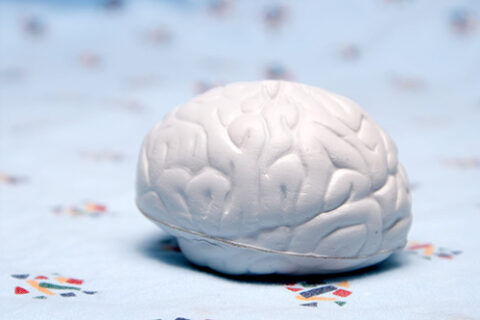Nanomaterials as switches in the brain
FAU researcher develops high-precision and gentle treatment method for the treatment of neurological conditions.
Functional nanomaterials could soon control the activity of neurons in the brain. By using this minimally-invasive method, Prof Dr. Danijela Gregurec hopes to revolutionize the treatment of neurological disorders such as depression, panic attacks, epilepsy or Alzheimer’s. In conjunction with researchers from Italy, Spain, the UK, and Finland, FAU chemist Gregurec has launched the BRAINSTORM project, which has received 3 million euros of funding from the EU, 740,000 euros of which have been awarded to FAU. Gregurec’s vision involves not only wireless control of neural networks, but also communication with individual proteins thus gaining a deeper understanding of how our brains function.
It sounds like the plot of a sci-fi novel: Magnetic nanoparticles are injected into the bloodstream, pass through the blood-brain barrier using a strong ultrasound signal, and are distributed in the brain tissue. When excited using an external magnetic field, the particles have either a mechanical or thermal effect on neurons and can precisely suppress or stimulate brain activity even in the deepest regions. “This minimally-invasive procedure will enable us to treat serious neurological disorders such as depression, panic attacks, Alzheimer’s or Parkinson’s in exactly the right place with precise timing or to restore the balance of neuron activity after seizures,” explains Danijela Gregurec. “Up to now, such interventions have mostly been based on strong electric stimulations from invasive electrode implants, which is often uncomfortable for patients and can have serious side effects.”
Gregurec, who is originally from Croatia, is working on making her vision a standard procedure in treatments for neurological conditions. She is professor of sensory sciences at the Chair of Aroma and Smell Research at FAU and focuses on the synthesis of materials on the nanoscale, to which she imparts specific physiochemical properties. Before transferring to Erlangen at the end of 2022, she worked at the Research Laboratory of Electronics at Massachusetts Institute of Technology (MIT) and a the McGovern Institute for Brain Research. “This is where I started connecting seemingly unfamiliar worlds with each other: materials science, the senses and the brain,” she explains. At FAU, she has found the ideal environment to drive forward her multi-disciplinary research in materials chemistry, neurobiology, biophysics, imaging and engineering. “I work with world-class researchers and, at the same time, I have the freedom to think and research “out of the box”, something I am very grateful for.”
Sending information to the brain – and receiving it
For her creative research at the interface between chemistry, materials science and medicine, Danijela Gregurec has now been awarded an EU Pathfinder Open Grant that is as prestigious as it is financially attractive. In conjunction with fellow researchers from Italy, Spain, the UK, and Finland, she will be working on the BRAINSTORM project for the next four years, which has received 3 million euros of funding from the EU, 740,000 euros of which have been awarded to FAU. The aim of BRAINSTORM is to develop a groundbreaking technology for wireless neuromodulation, on the basis of anisotropic ferromagnetic nanoparticles that are coated in a new functional polymer layer. “This combination of materials facilitates bimodal functionality,” explains Gregurec. “Depending on which external signals we send, the particles convert the energy from the magnetic field into heat or mechanical force.” In this way, the researchers hope to be able to manipulate the ion channels of proteins that are responsible for the sensory activity of nerve cells. With neurological hyperactivity, as is the case with panic attacks or epilepsy, they can have a balancing effect since they establish regular patterns of neural stimulation and suppression. With degenerative conditions such as dementia and Alzheimer’s on the other hand, they should stimulate activity and ideally lead to the regeneration of neural networks.
This new technology could replace conventional methods such as deep brain stimulation or transcranial magnetic stimulation that have serious disadvantages: They rely on implanting macroscopic electrodes, cannot influence targeted regions deep inside the brain and cannot differentiate between various types of neurons. Gregurec is convinced that her precise and minimally-invasive treatment method can increase the chances of recovery of patients with brain disorders and considerably improve the quality of life of those affected. Her vision goes above and beyond medical applications. “In future, we will not only be able to control neural networks with functional nanomaterials, but also communicate with individual sensory proteins,” she says. “This will enable us to receive information from the complex and puzzling depths of the brain and thus provide us with new groundbreaking findings.”
Further information
Prof. Dr. Danijela Gregurec
Professorship of Sensory Sciences
